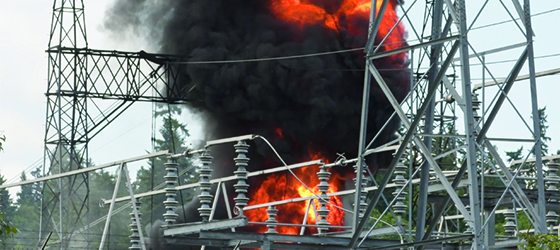 |
 |
|
Welcome to National Grid’s Tips of the Trade for first responders. These tips are intended to help you respond safely and effectively to incidents involving natural gas and electricity. Please review them with your team.
|
|
| Responding to substation incidents |
|
| Danger lies beyond the gates |
Substations are secured areas that support the efficient transmission and distribution of electricity. They contain transformers and other equipment that reduce very high-voltage electricity to levels suitable for the local distribution grid.
Substations contain multiple shock hazards, including capacitors, batteries, transformers and uninsulated conductors, with the potential to arc over significant distances. And the liquid and gaseous chemicals present in substation equipment – such as dielectric fluid, transformer oils and sulfuric acid – make fires in these facilities especially dangerous. |
 |
| Unless directed otherwise by National Grid personnel, always stay outside the fenced area of a substation. |
| Do not enter! |
If you arrive at a substation incident before National Grid, contact the utility and remain outside all locked doors, gates and fenced areas. Under no circumstances should you enter the substation before National Grid personnel arrive. While you wait for utility personnel, take these steps:
- If equipment is burning, let it burn. Burning electrical equipment is already ruined and will be replaced. Do not risk injury to protect equipment that will not be repaired.
- Protect nearby exposures per the 30/30/100 rule: stay 30 feet away from energized objects and use a 30-degree fog pattern at 100 psi. DO NOT direct water into the substation.
- Isolate the area at least 300 feet in all directions. Keep unauthorized persons away.
- Be alert for transformer explosions, smoke hazards and oil releases. Stay upwind and consider initial downwind evacuation for at least 1000 feet.
- Monitor for oil runoff; direct it away from catch basins or surface waters.
|
| Respond conservatively to substation fires |
|
|
Always consider a substation to be a hazardous environment where a safe response requires a high level of situational awareness.
When responding to a fire inside a substation, resist the natural impulse toward aggressive action. Enter a substation ONLY if specifically directed to do so by your incident commander and AFTER National Grid confirms equipment has been de-energized.
If you are directed to suppress a substation fire, position emergency vehicles at least 30 feet away from any power line. To avoid contact with overhead facilities, use nonconductive ladders and tools, carry them parallel to the ground and keep them below shoulder level.
With equipment de-energized, a transformer oil fire can be extinguished by using protein foam and water fog streams. Never use a solid stream of water on oil as it can spread the fire. Report all oil releases to the incident commander and National Grid, and follow standard tactics for a hazardous materials response.
|
|
|
|
|
For more first responder safety information, visit
firstresponder.ngridsafety.com. |
|
|
|
|
|
|
|
| Connect with us: |
#11670 © 2019 Culver Media, LLC |
|
|
|
|
|
|